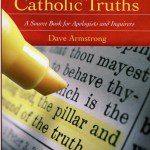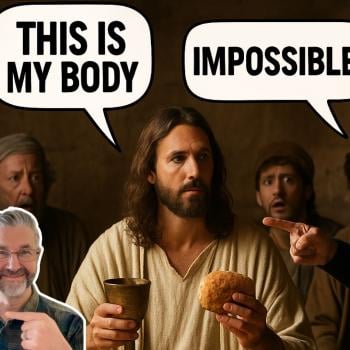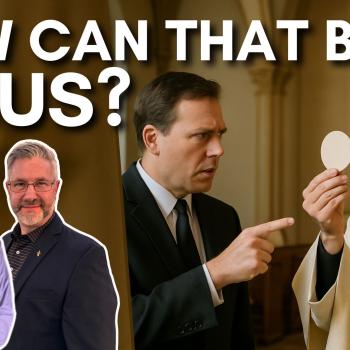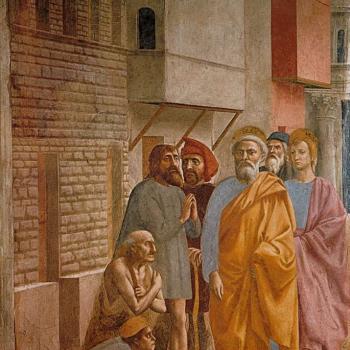1) Incense as a metaphor for prayer (smoke ascending) or accompanied by prayer is an explicit biblical theme.
2) The metaphor of God smelling fragrances from incense and sacrifices and being pleased is also an explicit biblical theme.
3) The intended Catholic symbolism of candles (prayer rising to God from a burning thing, as represented by smoke and possibly also fragrance) is exactly analogous to the same qualities in incense.
4) Therefore, the essence of the symbolism of the candle is a thing which is biblically explicit, even though candles themselves aren’t mentioned in the Bible.
5) What the candle is made of (wax) is wholly secondary in importance to that which it does, which is the essence of the symbolism.
But Protestants rarely reason in this fashion. It’s foreign to them, and so to the Protestant mind it often seems like desperation or special pleading. However, types and shadows, symbolism, metaphor, double meanings, parables, etc. are all very common biblical motifs. So this method of reasoning is quite biblical.
But there is also explicit evidence for candles in the Bible as well: in the form of “lamps”: essentially an oil lamp or candle-like item, with a wick that burns. The classic form of this is the menorah, or seven-branched lampstand, which has often been used as a symbol of Judaism. First I shall cite instances of lamps and lampstands being used in the context of temple worship in the Old Covenant (see all 131 examples of these words):
Exodus 25:31-38 And you shall make a lampstand of pure gold. The base and the shaft of the lampstand shall be made of hammered work; its cups, its capitals, and its flowers shall be of one piece with it; and there shall be six branches going out of its sides, three branches of the lampstand out of one side of it and three branches of the lampstand out of the other side of it; three cups made like almonds, each with capital and flower, on one branch, and three cups made like almonds, each with capital and flower, on the other branch — so for the six branches going out of the lampstand; and on the lampstand itself four cups made like almonds, with their capitals and flowers, and a capital of one piece with it under each pair of the six branches going out from the lampstand. Their capitals and their branches shall be of one piece with it, the whole of it one piece of hammered work of pure gold. And you shall make the seven lamps for it; and the lamps shall be set up so as to give light upon the space in front of it. Its snuffers and their trays shall be of pure gold. (cf. 26:35; Num 3:31; 4:9; 8:2-4; 1 Sam 3:3; 1 Ki 7:49; 1 Chron 28:15; 2 Chron 4:7,20-21; Jer 52:19; Zech 4:2,11)
Exodus 27:19-20 All the utensils of the tabernacle for every use, and all its pegs and all the pegs of the court, shall be of bronze. And you shall command the people of Israel that they bring to you pure beaten olive oil for the light, that a lamp may be set up to burn continually. (cf. Lev 24:2-4
Exodus 30:7-8 And Aaron shall burn fragrant incense on it; every morning when he dresses the lamps he shall burn it, and when Aaron sets up the lamps in the evening, he shall burn it, a perpetual incense before the LORD throughout your generations. (cf. 30:27; 31:8; 35:14; 37:17-23; 39:37; 40:4)
Exodus 40:24-25 And he put the lampstand in the tent of meeting, opposite the table on the south side of the tabernacle, and set up the lamps before the LORD; as the LORD had commanded Moses.
2 Chronicles 13:11 They offer to the LORD every morning and every evening burnt offerings and incense of sweet spices, set out the showbread on the table of pure gold, and care for the golden lampstand that its lamps may burn every evening; for we keep the charge of the LORD our God, but you have forsaken him.
2 Chronicles 29:7 They also shut the doors of the vestibule and put out the lamps, and have not burned incense or offered burnt offerings in the holy place to the God of Israel.
1 Maccabees 4:49-50 They made new holy vessels, and brought the lampstand, the altar of incense, and the table into the temple. Then they burned incense on the altar and lighted the lamps on the lampstand, and these gave light in the temple.
2 Maccabees 10:3 They purified the sanctuary, and made another altar of sacrifice; then, striking fire out of flint, they offered sacrifices, after a lapse of two years, and they burned incense and lighted lamps and set out the bread of the Presence.
Hebrews 9:2 For a tent was prepared, the outer one, in which were the lampstand and the table and the bread of the Presence; it is called the Holy Place.
Revelation 1:12-13, 20 Then I turned to see the voice that was speaking to me, and on turning I saw seven golden lampstands, and in the midst of the lampstands one like a son of man, clothed with a long robe and with a golden girdle round his breast; . . . As for the mystery of the seven stars which you saw in my right hand, and the seven golden lampstands, the seven stars are the angels of the seven churches and the seven lampstands are the seven churches.
Revelation 2:1, 5 To the angel of the church in Ephesus write: “The words of him who holds the seven stars in his right hand, who walks among the seven golden lampstands. . . . Remember then from what you have fallen, repent and do the works you did at first. If not, I will come to you and remove your lampstand from its place, unless you repent.”
Revelation 4:5 From the throne issue flashes of lightning, and voices and peals of thunder, and before the throne burn seven torches of fire, which are the seven spirits of God;
The King James Bible often uses candle or candlestick in these passages and others (see 78 examples). The American Standard Version of 1901 maintained this usage in many passages also. But the Greek lychnos and lychnia describe (technically) oil lamps, not candles per se (made of wax: as we know them today). These were containers filled with olive oil, into which a wick of flax or hemp were inserted.
*****
***












